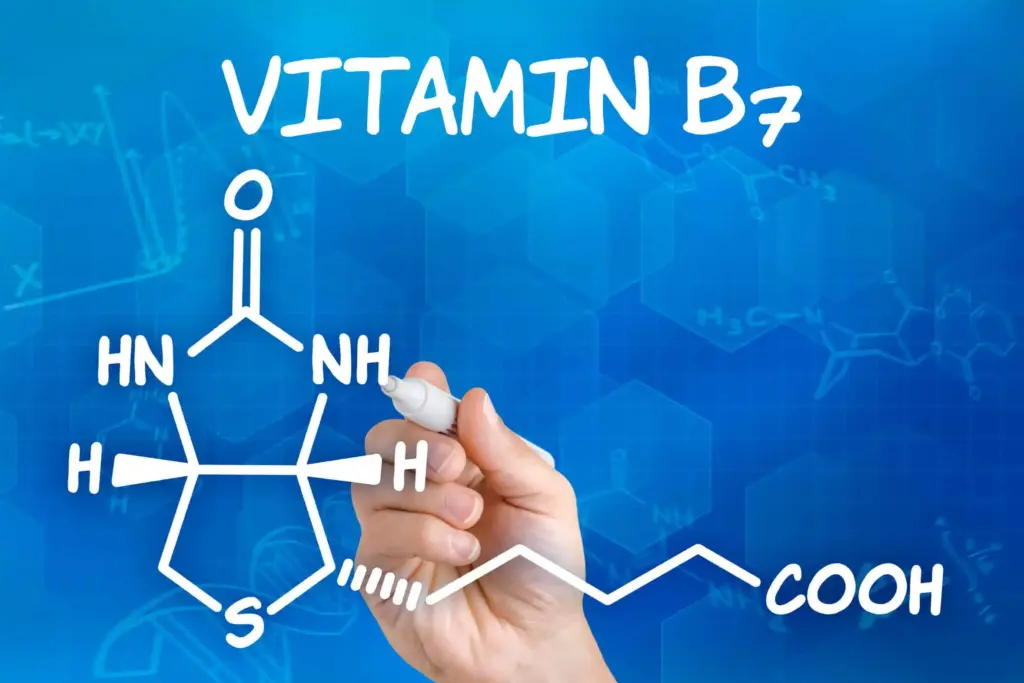Introduction
Biotin is also known as vitamin B7 or vitamin H. In the human body, it is involved in fat and protein metabolism, and is also needed to maintain healthy skin, nails and hair. Biotin (vitamin H) is found in many foods. Its content in liver, yeast, egg yolk, oatmeal, nuts, spinach, unpeeled rice and kidneys is particularly high. The German Nutrition Society advises adults to consume about 30 to 60 micrograms daily. However, the exact requirement is still largely unknown, as corresponding studies are still lacking. However, if you eat a balanced and varied diet, you can easily cover the estimated value with your food. Example: 150 grams of peanuts already supply the full daily requirement of biotin (vitamin H).
The discovery of the vitamin took place in several small steps and began in 1898, but it was not until 1936 that scientists first succeeded in isolating biotin (vitamin H) from dried egg yolk. The chemical structure was not completely clarified until 1942.
Biotin – the powerful vitamin for skin, hair and nails immensely important
According to the Federal Institute for Risk Assessment, an overdose of biotin – the powerful vitamin for skin – is actually not possible, so there is generally no upper limit for intake. For safety’s sake and as a preventive measure, however, it is pointed out that the daily amount should not exceed 180 micrograms. Whether a severe overdose could lead to side effects or health effects has not been clarified to date. A toxicity could never be proven, because like all other water-soluble vitamins, excess biotin – the powerful vitamin for skin – is simply excreted with the urine.
On the other hand, an undersupply can have consequences, but these only become noticeable after a longer period of time. Symptoms include loss of appetite, muscle pain and hair loss, and can also lead to disorders of the entire nervous system. A deficiency of biotin – the powerful vitamin for skin -can also promote the development of depression. For pregnant women, an undersupply can have serious consequences in the worst case, and women should make sure that their intake is sufficient. Important: Those who regularly eat raw eggs also risk a deficiency of biotin – the powerful vitamin for skin. The substance avidin, which is present in the egg white, is responsible for this. It binds the vitamin and thus removes it from the body. However, avidin is ineffective in heated or cooked eggs.
Biotin in cosmetics
For cosmetics, biotin – the powerful vitamin for skin – is of great importance. Without the vitamin the healthy and constant formation of hair, skin and nails would not be possible at all. The reason: Our body can produce the important keratin only if there is enough biotin – the powerful vitamin for skin – in the organism. The protein keratin is a valuable hornysubstance, without which skin, hair and nails would be weak and vulnerable to external influences. Thin, rough hair or even hair loss, brittle nails and an impaired skin condition would be the consequences.
By the way, the name vitamin H, which is also commonly used for biotin, is simply an abbreviation for the word “skin”, which impressively proves the immense importance of the substance. Meanwhile, many high-quality shampoos and conditioners containing biotin – the powerful vitamin for skin – are available on the market. It is also contained in many cosmetic nail hardeners. The nails gain strength and also grow much faster. Dietary supplements in the form of biotin tablets and biotin capsules are also popular and can positively influence or improve the health of skin, hair and nails. Corresponding products usually contain zinc, which additionally strengthens the positive effect. Zinc is a trace element that provides the skin with moisture, strengthens the nails and can prevent hair loss.
Meanwhile, biotin – the powerful vitamin for skin – has also found its way into the diets of our pets. The vitamin is said to help dogs and cats in particular to have a healthy and shiny coat. In horses, the vitamin even ensures particularly strong and resistant hooves.
Biotin fact sheet
Alternative names: Vitamin B7, Vitamin H, D-Biotin
CAS number: 58-85-5
Properties: solid, colorless needles
Melting point: 232 to 233 degrees Celsius
Solubility: soluble in water and ethanol
Molecular Formula: C10H16N2O3S
Physiological function: coenzyme in biochemical carboxylation reactions
INCI-function: antiseborrheic, hair conditioning, hair nurturing
Conclusion: Biotin – the powerful vitamin for skin – improves the keratin structure of skin, hair and nails
If you want to treat your hair, skin and nails to something good, you can use preparations with biotin – the powerful vitamin for skin – without hesitation, because there are no side effects even with an overdose. However, the positive effect does not occur immediately, especially with dietary supplements (tablets or pills), a result is usually visible after about two to three months. In addition, many cosmetic products such as hair conditioners, shampoos or nail hardeners are available on the market. An increased supply of biotin is also used for therapeutic purposes. For example, the vitamin can relieve the symptoms of chronic eczema, neurodermatitis, urticaria, psoriasis and allergic skin reactions, among others.
We use the active ingredient Biotin described above in our high-quality private label products, which meets the highest standards of effectiveness, skin compatibility, and innovation. We combine proven ingredients with modern biotechnological developments to create tailor-made formulations that meet the individual needs of your target group. Our focus is on quality, transparency, and the optimal synergy of all ingredients—for visible results and a compelling brand experience.
Tojo Cosmetics Private Label—your brand, our passion for effectiveness and quality.
Interested? Contact us now with no obligation.
Literature:
Vitamine; Hans K. Biesalski, Jürgen Schrezenmeir, Peter Weber, Hubert E. Weiß, Thieme-Verlag
AACC Guidance Document on Biotin Interference in Laboratory Tests.
Li D, Ferguson A, Cervinski MA, Lynch KL, Kyle PB.J Appl Lab Med. 2020 May 1;5(3):575-587.

